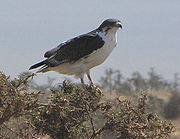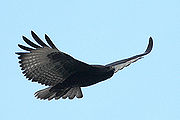
Augur Buzzard
Encyclopedia
The Augur Buzzard is a 55–60 cm long Africa
n bird of prey
. The taxonomy on this species is confusing, with some taxonomists considering this species, the Jackal Buzzard
, and the Archer's Buzzard
to be the same superspecies
. Many taxonomists consider them all to be distinct, having different calls, different home ranges and variations in plumage. This is a species of mountains (most typically at about 2000 m altitude, but up to 5000 m), and adjacent savannah and grassland. It is resident and non-migratory
throughout its range. It is normally found from Ethiopia
to southern Angola
and central Namibia

 The adult Augur Buzzard is strikingly plumaged. It is almost black above with a rufous tail. The primary flight feathers are blackish and the secondaries off-white, both barred with black. Below the chin and around the throat is mainly white, and the rest of the underparts and the underwing coverts are rich rufous. The flight feathers from below are white, tipped with black to form a dark trailing edge to the wing.
The adult Augur Buzzard is strikingly plumaged. It is almost black above with a rufous tail. The primary flight feathers are blackish and the secondaries off-white, both barred with black. Below the chin and around the throat is mainly white, and the rest of the underparts and the underwing coverts are rich rufous. The flight feathers from below are white, tipped with black to form a dark trailing edge to the wing.
The juvenile Augur Buzzard is mainly brown above and rufous brown below and on the tail. It can be confused with wintering Steppe Buzzard
, but has broader wings and an unbarred undertail.
The adult Augur Buzzard has white underparts and underwings. The female has black on the lower throat. Juveniles are brown above and buff below, the underparts later becoming white. There is a melanistic form of Augur Buzzard, all black, except for grey and black-barred flight feathers and a chestnut tail. About 10% of birds are melanistic, but the proportion rises in forested areas with high rainfall to as much as 50% in some areas.
The eggs hatch in about 40 days, and after a further 56–60 days they can attempt flight. At 70 days they become independent of the nest, but young birds may then be seen with the adult pair for some time.
The diet of the Augur Buzzard is mainly small ground mammals, but snakes, lizards, small ground birds, insects, and road-kill are also taken. Typically, the raptor drops on its prey from a perch or hover.
Africa
Africa is the world's second largest and second most populous continent, after Asia. At about 30.2 million km² including adjacent islands, it covers 6% of the Earth's total surface area and 20.4% of the total land area...
n bird of prey
Bird of prey
Birds of prey are birds that hunt for food primarily on the wing, using their keen senses, especially vision. They are defined as birds that primarily hunt vertebrates, including other birds. Their talons and beaks tend to be relatively large, powerful and adapted for tearing and/or piercing flesh....
. The taxonomy on this species is confusing, with some taxonomists considering this species, the Jackal Buzzard
Jackal Buzzard
The Jackal Buzzard is a 45–55 cm long African bird of prey. The taxonomy on this species is confusing, with some taxonomists considering this species, the Archer's Buzzard, and the Augur Buzzard to be the same superspecies. Many taxonomists consider them all to be distinct, having different...
, and the Archer's Buzzard
Archer's Buzzard
The Archer's Buzzard is a 50–55 cm long African bird of prey. The taxonomy on this species is confusing, with some taxonomists considering this species, the Jackal Buzzard, and the Augur Buzzard to be the same superspecies. Many taxonomists consider them all to be distinct, having different...
to be the same superspecies
Superspecies
A superspecies is a group of at least two more or less distinctive species with approximately parapatric distributions. Not all species complexes, whether cryptices or ring species are superspecies, and vice versa, but many are...
. Many taxonomists consider them all to be distinct, having different calls, different home ranges and variations in plumage. This is a species of mountains (most typically at about 2000 m altitude, but up to 5000 m), and adjacent savannah and grassland. It is resident and non-migratory
Bird migration
Bird migration is the regular seasonal journey undertaken by many species of birds. Bird movements include those made in response to changes in food availability, habitat or weather. Sometimes, journeys are not termed "true migration" because they are irregular or in only one direction...
throughout its range. It is normally found from Ethiopia
Ethiopia
Ethiopia , officially known as the Federal Democratic Republic of Ethiopia, is a country located in the Horn of Africa. It is the second-most populous nation in Africa, with over 82 million inhabitants, and the tenth-largest by area, occupying 1,100,000 km2...
to southern Angola
Angola
Angola, officially the Republic of Angola , is a country in south-central Africa bordered by Namibia on the south, the Democratic Republic of the Congo on the north, and Zambia on the east; its west coast is on the Atlantic Ocean with Luanda as its capital city...
and central Namibia
Namibia
Namibia, officially the Republic of Namibia , is a country in southern Africa whose western border is the Atlantic Ocean. It shares land borders with Angola and Zambia to the north, Botswana to the east and South Africa to the south and east. It gained independence from South Africa on 21 March...
Description


The juvenile Augur Buzzard is mainly brown above and rufous brown below and on the tail. It can be confused with wintering Steppe Buzzard
Common Buzzard
The Common Buzzard is a medium to large bird of prey, whose range covers most of Europe and extends into Asia. It is usually resident all year, except in the coldest parts of its range, and in the case of one subspecies.-Description:...
, but has broader wings and an unbarred undertail.
The adult Augur Buzzard has white underparts and underwings. The female has black on the lower throat. Juveniles are brown above and buff below, the underparts later becoming white. There is a melanistic form of Augur Buzzard, all black, except for grey and black-barred flight feathers and a chestnut tail. About 10% of birds are melanistic, but the proportion rises in forested areas with high rainfall to as much as 50% in some areas.
Behaviour
Pairs have noisy aerial displays, including outside the breeding season. The large (up to 1 m wide) stick nest is built in a tree or on a crag, and is often reused and enlarged in subsequent seasons. Two creamy or bluish white eggs are laid and incubated by the female only, although food is brought to her on the nest by the male.The eggs hatch in about 40 days, and after a further 56–60 days they can attempt flight. At 70 days they become independent of the nest, but young birds may then be seen with the adult pair for some time.
The diet of the Augur Buzzard is mainly small ground mammals, but snakes, lizards, small ground birds, insects, and road-kill are also taken. Typically, the raptor drops on its prey from a perch or hover.

